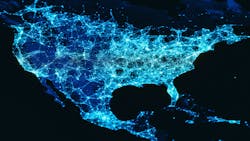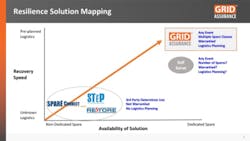Electric Grid Restoration: Rapid and Reliable Replacement of Critical Assets
America’s electric grid is our most critical piece of energy infrastructure. But it faces increasing threats and challenges which will affect its reliability and resilience.
A recent U.S. Department of Defense report found that, in addition to the threats of physical and cyber security attacks and severe weather events, climate change may present a growing threat that can increase the frequency of damage to grid assets and leave our nation vulnerable over time.
Other factors compounding these evolving threats is our dependence on foreign suppliers as well as our aging grid infrastructure. For example, extra high voltage (EHV) transformers, critical elements of the transmission infrastructure, are often sourced from abroad and the existing fleet of assets are aging faster than they’re being replaced. And even more will be needed in the coming years as the transmission system expands to integrate new renewable energy generation.
Securing a more certain future for the electric grid
Utilities need to find the right balance to achieve resilience at optimum cost. To do so they need to mitigate their risk. With regard to the threat of widespread damage to assets at multiple locations, this requires them to analyze their risks and develop an executable and effective plan to address them. Such plans must ensure the certainty of immediate access and delivery of replacement equipment.
Among the alternative spare equipment programs available, most are designed only to partially meet the evolving requirements for fast, flexible, and certain grid restoration.
The EEI Spare Transformer Equipment Program (STEP) is a valuable form of mutual assistance among Investor Owned Utilities (IOUs) that, provides a process for acquiring an asset from another utility but only in the event of a terrorist attack. Moreover, STEP requires a presidential decree, which to date, has yet to be enacted. Each participating utility is required to make a limited number of assets (often only one) available in such event.
The EEI SPAREConnect program provides an additional complementary mechanism for IOU Bulk Power System asset owners and operators to network with other SPAREConnect participants for the possible sharing of transmission and generation step-up transformers and other equipment. However, SpareConnect does not create or manage a central database of spare equipment. Consequently, a utility in need has no certainty whether what they need exists, and if it does, who has it, where is it, or its condition, age or availability. The company in need owns the responsibility to reach out to other participants, but there is no obligation for potential donor companies to provide an asset.
The North American Transmission Forum’s (NATF) Regional Equipment Sharing for Transmission Outage Restoration (RESTORE) Program is also a form of mutual assistance, designed to enhance resiliency and reliability of the energy grid by identifying sources and facilitating replacement of equipment from among the available spares at the participating companies following disaster events. This optional, self-funding program is available to NATF members for a minimal additional cost. When a participant makes their need known, a committee presides over which other participant(s) will provide spare assets to meet the need. But again, the specific availability, quantity, quality, condition and warranty of the equipment is not guaranteed.
Grid restoration requires secure and fast access to critical transmission equipment
Restoring the grid after natural or man-made events affecting multiple grid facilities at once can be a matter of life and death. Prolonged outages impact the most vulnerable in our society more than other populations and can lead to loss of jobs, health problems and even death.
Speedy restoration is critical. But extra high voltage transformers and other critical transmission equipment have extremely long lead-times for procurement. This equipment is also difficult to transport, requiring even more time to deliver or relocate to where it is needed.
When an EHV transformer wears out or is damaged by external forces the process of replacing it with another can be lengthy. Due to redundancy of design, a single transmission transformer outage will rarely cause customer outages. However, a more extreme event that damages multiple transformers at several locations can disrupt businesses and communities that rely on the grid for long periods of time. These extreme events are rare but as mentioned earlier, the threat of such events has risen.
It is estimated that it can take anywhere between 12 and 30 months to acquire a new EHV transformer and growing supply chain and materials issues are extending this replacement time even further. The U.S. imports 85% of its EHV transformers and there is competition with other nations for limited production and raw materials such as special grade electrical steel. These transformers’ hefty price tag can range from $2.5 to $10 million dollars (including transportation and installation). Finally, the transformers are typically custom built, with long lead-times to design, bid, manufacture and deliver; with components dependent on foreign production and supply chains.
Grid resilience—a gap in planning for equipment replacement
As EHV transformers have become more critical, their value has increased. And lead times have increased in obtaining these assets.
It is important for investor owned utilities and other transmission owning companies to have access to spare equipment regardless of how a transformer or other critical piece of transmission equipment may fail or be damaged.
Utilities’ self-supplying their backup equipment generally maintain some number of spares on the system. The number is generally determined based upon operational failure rates and generally does not take into account widespread, concurrent multi-facility failures due to extreme events. The spares on hand also are typically stored or co-located at the site of one of the operating transformers to minimize transportation time.
However, for extreme events such as physical attacks, severe weather, or other natural disasters, these co-located spares would likely be damaged along with the operating transformer, so the spare become useless. Even if a utility should be so fortunate to hold enough undamaged operational spares to replace what has been destroyed, replenishing their stock of spares will require procurement times of typically 12-18 months but may now require up to 30 months. In today’s supply chain environment, these longer lead-times can be expected.
Subscribing to an industry-led solution that includes a secure, dedicated domestic inventory of pooled equipment, stored remote from the operating sites can deliver the right balance of maximizing certainty and speed at an optimum cost.
Grid Assurance is the industry’s only grid restoration solution with a fully functional, securely stored, warranted and maintained reserve of critical equipment combined with pre-approved delivery logistics plans to help transmission companies get the power back on quickly and efficiently. Subscribers have rights to immediate access their subscribed number of spares without restrictions, delays, or contingent upon approval of a committee or a presidential decree. They also have advance knowledge and certainty of the specific performance and physical characteristics of the exact equipment they will receive. Their subscription allows them to purchase the transformers at the original equipment price (known) and with a manufacturer’s warranty transferable to them at the time of sale. Participating in other industry programs may add value as additional back-up resources, and their limitations are overcome by subscribing to the Grid Assurance model.
Utilities need an all threats solution that restores power faster and helps to protect reputational risks. They need access to a certain, secure, domestic inventory of critical transmission that is ready for deployment at a moment’s notice.
David E. Rupert is Chief Executive Officer at Grid Assurance.
About the Author
David E. Rupert
David E. Rupert advocates for and promotes the Breakthrough Overhead Line Design (BOLD) advanced transmission technology to entities that desire a more efficient transmission line design. He earned a bachelor’s degree in business administration in production and operations management from Ohio State University, a juris doctor degree from Capital University Law School and a J.D./MBA from Capital University Law School. He also attended American Electric Power’s executive education program at Ohio State University and the transmission and wholesale markets school at the University of Wisconsin.

